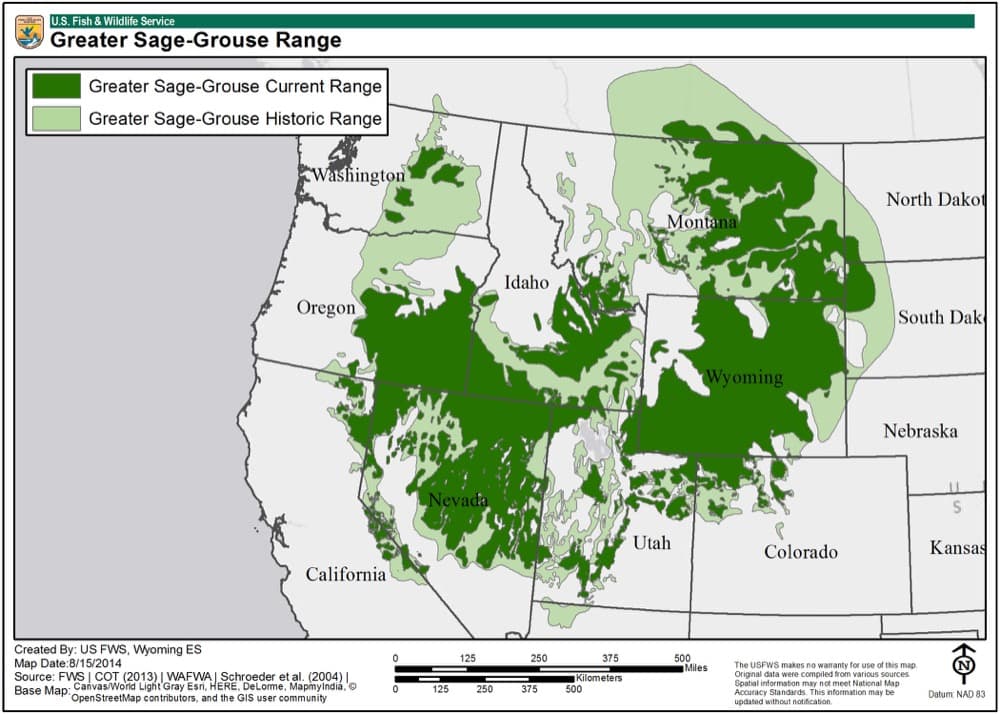This is a sage grouse.

Maybe you want to pet its neck, or maybe you are scared of its nasty dinosaur head. Maybe you prefer its cuter cousin, the lesser prairie chicken. Fair enough. But who could be mad about this bird?
A lot of people, actually.
See, the greater sage grouse likes to nest where people increasingly like to do some of their favorite people things, like drilling for oil and building houses.
This simple bird, which loves nothing more than doing sexy dances for its mate (see below; viewer discretion is advised), is at the center of a web of lawsuits between industry groups, the federal government and numerous smaller governments throughout the West.
There are threats aplenty for the sage grouse.
The development of the West has driven the birds' population into a sharp decline. Current estimates say there are between 200,000 and 500,000 breeding grouse, down from perhaps 16 million, and a good lot of them are in northwestern Colorado.
In all, their habitat acreage has shrunk by about 56 percent from its historic size, according to the Bureau of Land Management. Most of the bird's population groups are in significant decline, BLM reports.
Grouse are pretty sensitive animals. Their males like to say things like "swish-swish-coo-oopoink!" Their main defense is flying away, which they can do at 50 mph for several miles at a time.
The government has identified many specific threats to the tubby turkey of the West, including urbanization, invasive species and energy production.
Most importantly, they're really sensitive to changes in their habitat. They like to set up shop in sagebrush, a woody bush that has been replaced by grass on a lot of rangeland and other developed areas.
They're most present in northwestern Colorado.
Here's a map of where the sage grouse lives. (You'll have a good chance of seeing them in Gunnison.)

And that matters because there's a huge, controversial conservation effort happening.
The sage-grouse (plural: sage-grouse) is not an officially endangered species. The latest attempt to list it as one failed in September, when the Obama administration said it would instead support a cooperative effort to protect the bird.
There are now a number of strategies in play. For example, the state is setting up the Colorado Habitat Exchange, a marketplace that rewards people who protect grouse habitat.
More controversial: The federal government has placed new limits on the use of government lands in the West.
In particular, the government has delayed issuing leases that would allow oil and gas extraction on millions of acres. Other restrictions affect cattle grazing and mining. This is a big deal because the federal government owns a lot of the West, so its decisions affect whole industries.
So, unsurprisingly, oil and gas groups sued the federal government in May, as have attorneys general for Nevada, Idaho and Utah. The oil restrictions are a particular concern in northwestern Colorado, where grouse and oil alike are still common. This week, Garfield County commissioners complained that the feds showed preferential treatment to environmentalists over local officials.
Of course, environmentalists aren't uniformly happy with the new plans either. A lawsuit by WildEarth Guardians and other groups argues that the federal plan is too fragmented and full of loopholes to really help the sage grouse, particularly in Wyoming.
Here's that sexy grouse dance I mentioned.
But why the greater sage grouse?
If you believe this study by the Western Energy Alliance these new limitations will cancel out billions of dollars of economic activity. The alliance is a Denver-based lobbyist for oil and gas producers, so it has its biases -- but it raises the question of why this bird is so much.
Here's how the Washington Post puts it: The health of sage grouse "reflects the condition of a vast western sagebrush sea," which in turn supports hundred more species.
If you can save something as sensitive (and apparently dim) as the sage-grouse, then you're by default saving a lot more of the environment.
Of course, it's easy to flip that and see the grouse as a pawn used to advance government regulations that will in large part affect rural areas.
I don't have answers for that today. For further reading, I'd recommend this Bay Nature piece. Let's just agree that this is one crazy chicken.














